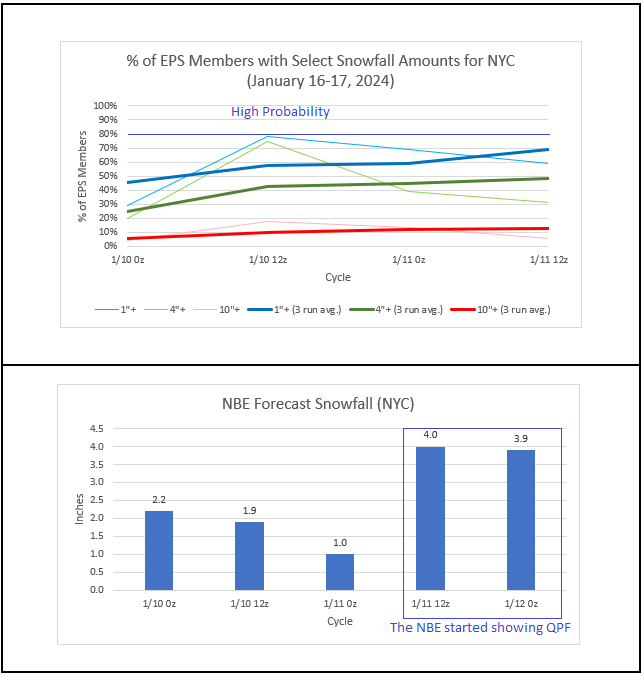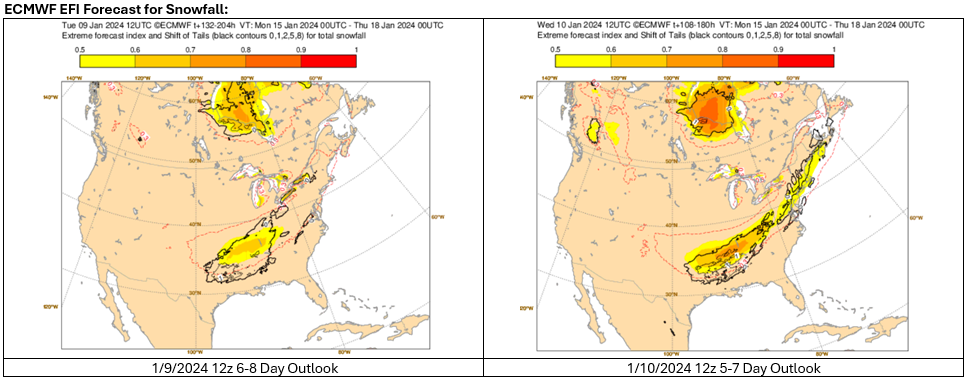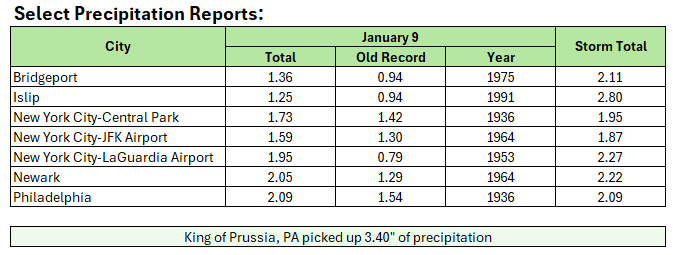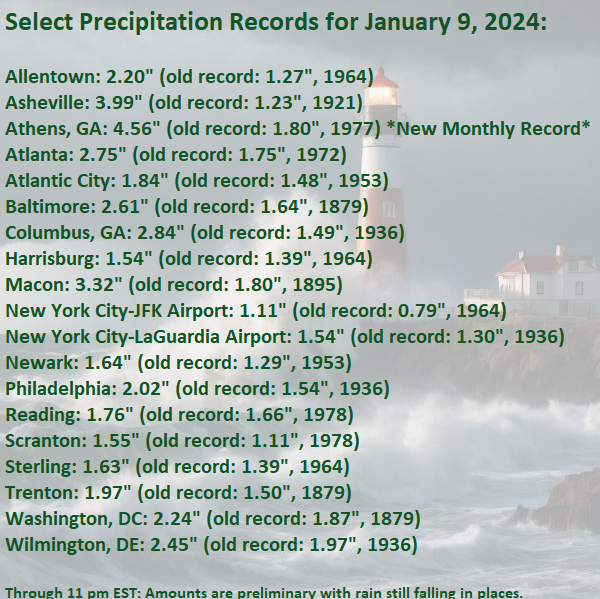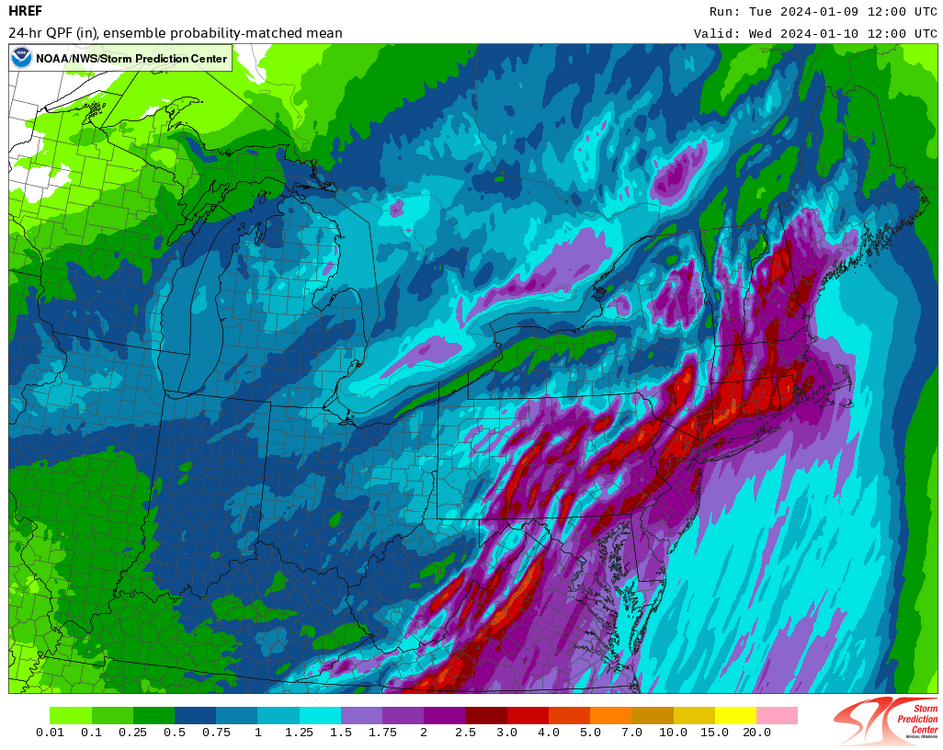-
Posts
22,982 -
Joined
Content Type
Profiles
Blogs
Forums
American Weather
Media Demo
Store
Gallery
Everything posted by donsutherland1
-
For January through mid-February, the PNA is often a critical factor.
-
I agree. The sample size of these events is small, which is unfortunate. Hopefully, the guidance will move toward a more impactful snow event.
-
The guidance is still in its early stages regarding the potential January 16-17 snow event. The 12z ECMWF showed a complete miss to the south and east, but so far that's an outlier. Historic experience with the forecast teleconnections would favor a light event in the northern Mid-Atlantic region and potentially a light or moderate event in southern New England. There was a single case during the forecast teleconnections that saw a major event: the historic January 1996 blizzard. EPS and NBE Outcomes: The 1/12 0z Probabilistic Winter Storm Severity Index: The situation remains complex. However, the guidance should begin to converge on a solution over the next several days.
- 1,593 replies
-
- 1
-

-
Another strong storm will bring rain and wind to the region later tomorrow into Saturday. The storm should bring a general 0.50"-1.50" rainfall with locally higher amounts. In addition, the temperature will again surge into the 50s across the region. Coastal flooding and beach erosion are likely. Winds could gust past 50 mph. Meanwhile, a genuine Arctic air mass will continue to advance deeper into the Continental U.S. over coming days. Severe cold is likely in the affected region. This cold air will likely come eastward in modified fashion. There is a chance that the low temperature could fall into the teens in New York City during the middle of next week. Prospects for at least some snowfall could also increase following the coming weekend. One such opportunity exists for January 16-17. Filtering for teleconnections (AO -3.5 to -1.5, NAO-, and PNA+ as currently forecast by the GEFS), there were 9 storms that brought 2" or more snow to at least one of the following cities during January 5-25, 1950-2023: Boston, New York City, Philadelphia, or Washington, DC. Those cities fared as follows: Boston: 2" or more: 67%; 4" or more: 44%; 6" or more: 11% New York City: 2" or more: 22%; 4" or more: 11%; 6" or more: 11% Philadelphia: 2" or more: 33%; 4" or more: 11%; 6" or more: 11% Washington, DC: 2" or more: 22%; 4" or more: 11%; 6" or more: 11% The 6"+ storm was the legendary January 1996 blizzard. Developments in coming days will be crucial in determining whether this latest opportunity for snowfall will be realized or if the region's snow drought will continue. Both options remain on the table. The ENSO Region 1+2 anomaly was +1.0°C and the Region 3.4 anomaly was +1.9°C for the week centered around January 3. For the past six weeks, the ENSO Region 1+2 anomaly has averaged +1.38°C and the ENSO Region 3.4 anomaly has averaged +1.97°C. A basinwide El Niño event is ongoing. The SOI was +7.73 today. The preliminary Arctic Oscillation (AO) was -2.147 today. Strong blocking in the final week of November, as occurred this year, has often been followed by frequent blocking in December and January. On January 9 the MJO was in Phase 2 at an amplitude of 1.284 (RMM). The January 8-adjusted amplitude was 0.929 (RMM). Based on sensitivity analysis applied to the latest guidance, there is an implied 63% probability that New York City will have a warmer than normal January (1991-2020 normal). January will likely finish with a mean temperature near 34.6° (0.9° above normal).
-
Upcoming storms: January 12-13: Model continuity remains good. A general 0.50"-1.50" rainfall with locally higher amounts remains likely. Strong winds gusting toward or above 50 mph, significant beach erosion, and coastal flooding are also likely. January 16-17: The guidance continues to offer a wide range of solutions. The 12z GFS shows a moderate to significant snowfall across the region. The 12z ECMWF has now suppresses the development and track of the storm well to the south and east of the region. Under the ECMWF's scenario, the regional snow drought would continue. Confidence in the development of a storm is medium. Confidence in details such as location of development, track and outcomes remains low. The NBE has taken a middle ground of sorts showing about 3" in New York City. Historically, most events in the forecast pattern have been light (<2") in the New York City and Philadelphia areas. The single exception is the Blizzard of January 1996. Odds may lean somewhat toward a lighter event than a heavy one. Overall, the situation is complex. Small changes in details concerning the synoptic pattern and short wave(s) can have a significant impact. Due to the level of uncertainty, all of the potential solutions remain on the table right now. Finally, a strong shot of cold air should advance into the region by midweek next week. New York City could see its first teens of the season.
-
Lots of uncertainty still exists with regard to the potential storm. It’s too early to celebrate (GFS) or mourn (GGEM).
- 1,593 replies
-
- 7
-

-

-
Another strong storm will bring additional rain and wind to the region Friday into Saturday. A general 0.50"-1.50" rainfall with locally higher amounts appears likely. In addition, the temperature will again surge into the 50s across the region. Coastal flooding appears likely. Meanwhile, a genuine Arctic air mass will be slowly advancing into the Pacific Northwest and Northern Plains. Severe cold is likely in the affected region. Afterward, this cold air could come eastward in modified fashion. That could set the stage for the coldest period so far this winter beginning on Sunday or Monday. There is a chance that the low temperature could fall into the teens in New York City during the middle of next week. Prospects for at least some snowfall could increase after the weekend. One such opportunity exists for January 16-17. Filtering for teleconnections (AO -3.5 to -1.5, NAO-, and PNA+ as currently forecast by the GEFS), there were 9 storms that brought 2" or more snow to at least one of the following cities during January 5-25, 1950-2023: Boston, New York City, Philadelphia, or Washington, DC. Those cities fared as follows: Boston: 2" or more: 67%; 4" or more: 44%; 6" or more: 11% New York City: 2" or more: 22%; 4" or more: 11%; 6" or more: 11% Philadelphia: 2" or more: 33%; 4" or more: 11%; 6" or more: 11% Washington, DC: 2" or more: 22%; 4" or more: 11%; 6" or more: 11% The 6"+ storm was the legendary January 1996 blizzard. Developments in coming days will be crucial in determining whether this latest opportunity for snowfall will be realized or if the region's snow drought will continue. For now, nothing is cast in stone, as can be seen from the dramatic differences between the January 10 12z and 18z runs of the GFS Model. The ENSO Region 1+2 anomaly was +1.0°C and the Region 3.4 anomaly was +1.9°C for the week centered around January 3. For the past six weeks, the ENSO Region 1+2 anomaly has averaged +1.38°C and the ENSO Region 3.4 anomaly has averaged +1.97°C. A basinwide El Niño event is ongoing. The SOI was +1.51 today. The preliminary Arctic Oscillation (AO) was -1.212 today. Strong blocking in the final week of November, as occurred this year, has often been followed by frequent blocking in December and January. Through January 10th, the AO has been negative on 66% of days and at or below -1.000 on 49% of days. On January 8 the MJO was in Phase 3 at an amplitude of 0.929 (RMM). The January 7-adjusted amplitude was 1.261 (RMM). Based on sensitivity analysis applied to the latest guidance, there is an implied 60% probability that New York City will have a warmer than normal January (1991-2020 normal). January will likely finish with a mean temperature near 34.5° (0.8° above normal).
-
Ensemble support for a possible January 16-17, 2024 snow event has increased among the EPS members. The ECMWF's Extreme Forecast Index (EFI) snowfall forecast has also improved for the timeframe over the past 24 hours. These are encouraging developments, but it is premature to reach concrete and detailed conclusions about the possible event.
-
There was a nice improvement on the 12z GFS and GGEM runs. All of the region picks up a light snowfall for 1/16-17 on the guidance, parts of New England see a moderate snowfall. The GGEM has a more robust solution. There still remains considerable uncertainty. Hopefully, continuity and consistency among the guidance can develop over the next few days.
-
The January 9-10, 2024 storm behaved quite well relative to expectations. Much of the region saw a general 1"-3" rainfall with some locally higher amounts. Winds gusted as high as 72 mph in the region. Another significant storm will affect the region later this week. January 12-13, 2024: Confidence in the storm remains high. An intensifying storm will bring moderate to heavy rain to the region (generally 0.50"-1.50" with some locally higher amounts of 2.00" or more). Gusty winds and coastal flooding are likely. The temperature will again surge into the 50s across the region. The same storm will bring Chicago a 6"-12" snowfall with potentially more. January 16-18, 2024: Low-to-Medium Confidence: Generally, the ECMWF had been hinting at a significant snowstorm during this range. Unlike with the January 6-7 event that was a very low ratio snowfall in parts of the region except well north and west of New York City and Newark, this storm would likely feature more typical ratios as per the guidance with the snowy outcomes. A few GFS runs subsequently picked up on the storm (as primarily a snowstorm) but the model abandoned that idea afterward. Overall, support for the snowstorm idea has not been strong or consistent. Ensemble support has recently decreased. On the 1/10 0z EPS, 29% of members had 1" or more snow in New York City while 20% had 4" or more. The 3-cycle averages were 46% and 25% respectively. At present, it is somewhat more likely than not that the New York City and Philadelphia areas won't see a moderate or greater snowstorm. It's a closer call for the Boston area. The arrival of the season's coldest weather so far by the middle of next week remains on course. New York City could see its low temperatures fall into the lower 20s or even the teens at the height of the cold. Elsewhere, Buffalo will end its record stretch without a low temperature in the teens, which will reach 319 days today. In doing so, Buffalo will record its latest first teens of the season. The old record was January 3 during winters 2015-16 and 2021-22. Four of Buffalo's five first teens in January (2023-24 is counted) have occurred since winter 2000-01. Buffalo's seasonal records go back to winter 1874-75.
-

Two Mdt to high impact events NYC subforum; wknd Jan 6-7 Incl OBS, and mid week Jan 9-10 (incl OBS). Total water equiv by 00z/11 general 2", possibly 6" includes snow-ice mainly interior. RVR flood potential increases Jan 10 and beyond. Damaging wind.
donsutherland1 replied to wdrag's topic in New York City Metro
Happy birthday.- 3,610 replies
-
- 1
-

-
- snow
- heavy rain
- (and 5 more)
-

Two Mdt to high impact events NYC subforum; wknd Jan 6-7 Incl OBS, and mid week Jan 9-10 (incl OBS). Total water equiv by 00z/11 general 2", possibly 6" includes snow-ice mainly interior. RVR flood potential increases Jan 10 and beyond. Damaging wind.
donsutherland1 replied to wdrag's topic in New York City Metro
Happy birthday in advance.- 3,610 replies
-
- 2
-

-
- snow
- heavy rain
- (and 5 more)
-

Two Mdt to high impact events NYC subforum; wknd Jan 6-7 Incl OBS, and mid week Jan 9-10 (incl OBS). Total water equiv by 00z/11 general 2", possibly 6" includes snow-ice mainly interior. RVR flood potential increases Jan 10 and beyond. Damaging wind.
donsutherland1 replied to wdrag's topic in New York City Metro
1 S Mamaroneck, NY recently recorded a 64 mph gust.- 3,610 replies
-
- snow
- heavy rain
- (and 5 more)
-

Two Mdt to high impact events NYC subforum; wknd Jan 6-7 Incl OBS, and mid week Jan 9-10 (incl OBS). Total water equiv by 00z/11 general 2", possibly 6" includes snow-ice mainly interior. RVR flood potential increases Jan 10 and beyond. Damaging wind.
donsutherland1 replied to wdrag's topic in New York City Metro
- 3,610 replies
-
- 1
-

-
- snow
- heavy rain
- (and 5 more)
-

Two Mdt to high impact events NYC subforum; wknd Jan 6-7 Incl OBS, and mid week Jan 9-10 (incl OBS). Total water equiv by 00z/11 general 2", possibly 6" includes snow-ice mainly interior. RVR flood potential increases Jan 10 and beyond. Damaging wind.
donsutherland1 replied to wdrag's topic in New York City Metro
Atlantic City has had gusts of 56 mph so far. 1 NE Brigantine, NJ had a 62 mph gust at 8:39 pm. JFK's 0.86" rainfall so far breaks the January 9th record of 0.79" from 1964.- 3,610 replies
-
- snow
- heavy rain
- (and 5 more)
-

Two Mdt to high impact events NYC subforum; wknd Jan 6-7 Incl OBS, and mid week Jan 9-10 (incl OBS). Total water equiv by 00z/11 general 2", possibly 6" includes snow-ice mainly interior. RVR flood potential increases Jan 10 and beyond. Damaging wind.
donsutherland1 replied to wdrag's topic in New York City Metro
Atlantic City recently experienced a 50 mph wind gust. At 6:54 pm 1 NNE Bethel, DE registered a 64 mph wind gust.- 3,610 replies
-
- snow
- heavy rain
- (and 5 more)
-
Earlier today, Asheville, NC picked up 3.99" of rain. That shattered the daily mark of 1.23" from 1921. It was also Asheville's second highest daily precipitation on record for January. Only January 7, 1998, another strong El Niño winter, saw more with 4.42". The storm responsible will bring a heavy windswept rain to much of the region tonight into tomorrow. A general 1"-3" rainfall with locally higher amounts is likely. The storm will also produce damaging winds with gusts of 50 mph to 60 mph with even higher gusts on parts of Long Island and the Connecticut shore. Moderate to major coastal flooding and significant beach erosion are likely. The temperature will likely surge into the middle 50s in New York City and Newark and toward or above 60° in Baltimore, Philadelphia, and Washington, DC. Clouds will break tomorrow, but a gusty wind will persist. Temperatures will fall during the afternoon. Another strong storm could bring additional rain and wind to the region Friday into Saturday. Meanwhile, a genuine Arctic air mass will be slowly advancing into the Pacific Northwest and Northern Plains. Severe cold is likely in the affected region. Afterward, this cold air could come eastward in modified fashion. That could set the stage for the coldest period so far this winter beginning on Sunday or Monday. Prospects for snow could also increase. The ENSO Region 1+2 anomaly was +1.0°C and the Region 3.4 anomaly was +1.9°C for the week centered around January 3. For the past six weeks, the ENSO Region 1+2 anomaly has averaged +1.38°C and the ENSO Region 3.4 anomaly has averaged +1.97°C. A basinwide El Niño event is ongoing. The SOI was +1.51 today. The preliminary Arctic Oscillation (AO) was -1.258 today. Strong blocking in the final week of November, as occurred this year, has often been followed by frequent blocking in December and January. On January 7 the MJO was in Phase 3 at an amplitude of 1.261 (RMM). The January 6-adjusted amplitude was 1.484 (RMM). Based on sensitivity analysis applied to the latest guidance, there is an implied 56% probability that New York City will have a warmer than normal January (1991-2020 normal). January will likely finish with a mean temperature near 34.3° (0.6° above normal).
-

Two Mdt to high impact events NYC subforum; wknd Jan 6-7 Incl OBS, and mid week Jan 9-10 (incl OBS). Total water equiv by 00z/11 general 2", possibly 6" includes snow-ice mainly interior. RVR flood potential increases Jan 10 and beyond. Damaging wind.
donsutherland1 replied to wdrag's topic in New York City Metro
Definitely not a good scenario. Hopefully, precipitation amounts will be less than modeled, but the guidance is concerning.- 3,610 replies
-
- snow
- heavy rain
- (and 5 more)
-

Two Mdt to high impact events NYC subforum; wknd Jan 6-7 Incl OBS, and mid week Jan 9-10 (incl OBS). Total water equiv by 00z/11 general 2", possibly 6" includes snow-ice mainly interior. RVR flood potential increases Jan 10 and beyond. Damaging wind.
donsutherland1 replied to wdrag's topic in New York City Metro
- 3,610 replies
-
- 1
-

-
- snow
- heavy rain
- (and 5 more)
-

Two Mdt to high impact events NYC subforum; wknd Jan 6-7 Incl OBS, and mid week Jan 9-10 (incl OBS). Total water equiv by 00z/11 general 2", possibly 6" includes snow-ice mainly interior. RVR flood potential increases Jan 10 and beyond. Damaging wind.
donsutherland1 replied to wdrag's topic in New York City Metro
The 0z HREF wind product brings 70 mph gusts to the south shore of Long Island (mean) but 60 mph to parts of Long Island (minimum). The range seems to have narrowed from yesterday's 12z guidance and today's 12z cycle is running. Let's see where things converge. 60 mph with widespread 50 mph gusts would still be nasty in a situation where the ground is saturated.- 3,610 replies
-
- 2
-

-

-
- snow
- heavy rain
- (and 5 more)
-
Those of us who read your work and your commentary know the time, thought and effort that goes into your forecasts. There's no question that they are original content. Ignore the noise, don't let it bother you, and keep doing what you're doing.
-
That cities such as Boston, New York, and Philadelphia have seen below normal snowfall so far this winter does not necessarily mean that they will have a horrible season. Most of the seasonal snowfall during strong El Niño events falls after January 15th. For example, at New York City, approximately 75% of seasonal snowfall occurs after January 15th in such cases and 50% on or after February 1st. For what it's worth, my seasonal snowfall guesses for select cities were as follows: DCA _NYC _BOS __ ORD _DTW _BUF ____ DEN _ SEA _ BTV 11.5 15.0 27.5 27.0 38.5 85.0 56.5 1.2 70.0
-
Congratulations on the wedding.
-
Today was a tranquil day. Under partly sunny skies, the temperature rose into the mild 40s across the northern Mid-Atlantic region. However, the calm is about to be shattered. A severe storm could bring a heavy windswept rain to much of the region late tomorrow into Wednesday. The potential exists for a 1"-3" rainfall with locally higher amounts, damaging winds with gusts of 50 mph to 60 mph, and possibly major coastal flooding. Significant beach erosion is also likely. Temperatures will likely surge into the middle 50s in New York City and Newark and toward or above 60° in Baltimore, Philadelphia, and Washington, DC. Another strong storm could bring additional rain and wind to the region Friday into Saturday. Meanwhile, a genuine Arctic air mass will begin advancing into the Pacific Northwest and Northern Plains later this week. Severe cold is likely in the affected region. Afterward, this cold air could come eastward in modified fashion. That could set the stage for the coldest period so far this winter beginning on Sunday or Monday. The ENSO Region 1+2 anomaly was +1.0°C and the Region 3.4 anomaly was +1.9°C for the week centered around January 3. For the past six weeks, the ENSO Region 1+2 anomaly has averaged +1.38°C and the ENSO Region 3.4 anomaly has averaged +1.97°C. A basinwide El Niño event is ongoing. The SOI was +1.37 today. The preliminary Arctic Oscillation (AO) was -1.515 today. Strong blocking in the final week of November, as occurred this year, has often been followed by frequent blocking in December and January. On January 6 the MJO was in Phase 3 at an amplitude of 1.484 (RMM). The January 5-adjusted amplitude was 2.023 (RMM). Based on sensitivity analysis applied to the latest guidance, there is an implied 57% probability that New York City will have a warmer than normal January (1991-2020 normal). January will likely finish with a mean temperature near 34.4° (0.7° above normal).


